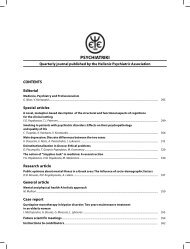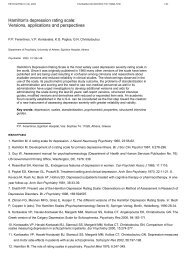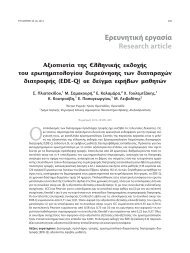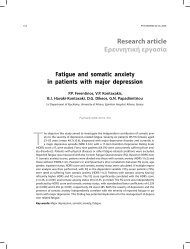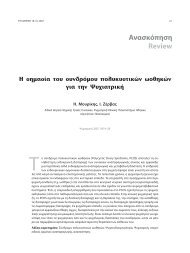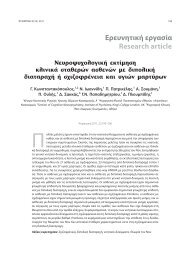Πλήρες Τεύχος - Ελληνική Ψυχιατρική Εταιρεία
Πλήρες Τεύχος - Ελληνική Ψυχιατρική Εταιρεία
Πλήρες Τεύχος - Ελληνική Ψυχιατρική Εταιρεία
Create successful ePaper yourself
Turn your PDF publications into a flip-book with our unique Google optimized e-Paper software.
PSYCHIATRIKI 22 (4), 2011 PSYCHOTROPIC MEDICATION ON IN CHILDREN 315IntroductionPediatric psychopharmacology is a field in rapidgrowth according to the expanding research and regulatoryaction. At the same time, this area is frequentlythe object of different and controversial debates in themedia and the general public because of the very delicateissue concerning the application of psychotropicagents in treatment of children and adolescents withmental disorders.Key elements in the field of pediatric psychopharmacologyinclude the specificities of the child development(in particular, the developing brain), psychopathology,chemical compounds that act on thebrain, and the therapeutic objectives. Because of that,clinicians must integrate information from variety ofsources in order to achieve coherent conclusions abouttreatment effects. However, pharmacological treatmentduring childhood and adolescence when theorganism undergoes marked developmental changesmay result in toxicities not seen in adults. 1,2 The administrationof agents acting on neurotransmitter systemsin rapid development may interfere with normal processesand result in unwanted long-lasting changes.Even though psychotropic drugs are increasinglymore present in the treatment of psychiatric disordersof children and adolescents, the efficacy and safetyhave been tested in only several groups of drugs. Thevast majority of psychotropic drugs are still prescribed“off-label”. 3–5 The off-label use of drugs is not in itself aninappropriate practice, because it is often supportedby considerable empirical evidence and is consistentwith treatment guidelines. However, it is importantto inform parents that medication is going to be prescribedoff-label before making treatment decisionsfor their child.Testing the safety and efficacy of psychotropic drugsin child psychiatry is particularly significant becauseof the huge differences in the metabolism of certaindrugs that were discovered in different age groups, i.e.a varying absorption rate, metabolism and excretionrates, frequently leading either to sub-dosing of medicationor pronounced side-effects. 6The decision to use psychotropic agents has to begrounded on a good diagnosis with the aim to improvethe patient’s well-being and to enable his or heroptimal growth and development. 3 The general ruleof thumb for introducing medication to children andadolescents is “start low, go slow, and taper slowly”. 7Pharmacoepidemiological analyses of the use ofmedication world-wide have shown great differencesin frequency of prescribing medication in clinicalpractice in different countries or even different mentalhealth centers of the same country, depending onthe predominant theoretical approach, medicationprices, or availability of drugs on the market. 6 For example,two thirds of antipsychotic medication prescribedto children and adolescents in the USA belongto the class of atypical antipsychotics, whereas thesame class of drugs is prescribed in only 5% of cases inGermany. 5 Over 70% of children and adolescents withmental health problems in Australia are receiving twoor more psychotropic drugs simultaneously, while only5% of child psychiatrists prescribe stimulants and antipsychoticsto children younger than 3 years. Roughlyaround 40% of indications for prescribing are off-labelindications. 8According to existing data, there is a trend of prescribingatypical antipsychotics (risperidone, clozapine)as well as an increase of antidepressant prescriptionsin Serbia’s adult population. 9 An assessment of drugprescribing trends in Serbia’s child and adolescentpopulation is necessary in order to evaluate currenttherapeutic practice and to compare it with principlesof rational pharmacotherapy worldwide, thus identifyingpossible downsides of current practices and point away towards safer and more efficient practices. 5,10Materials and methodThis is a descriptive study of prescribing trends atthe Clinical Department for Children and Adolescentsof the Institute of Mental Health in Belgrade, Serbia,during the period from September 2009 to September2010.Analyzed demographic data (age, gender) and thenumber of hospitalizations were obtained from medicalhistories, while diagnoses were obtained fromdischarge notes. Prescribed therapy was copied frommedication charts. Drug dosages are presented as averagedaily doses prescribed during the hospitalization.Dosages are analyzed and compared to the recommendeddaily dose, average age of patients, as well asto gender and number of previous hospitalizations.Psychiatric diagnoses are classified according to TheInternational Classification of Diseases and RelatedHealth Problems, 10th Revision (ICD-10), 13 while drugs




